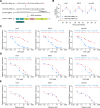Viral hijacking of host DDX60 promotes Crimean-Congo haemorrhagic fever virus replication via G-quadruplex unwinding
- PMID: 40577441
- PMCID: PMC12221184
- DOI: 10.1371/journal.ppat.1013278
Viral hijacking of host DDX60 promotes Crimean-Congo haemorrhagic fever virus replication via G-quadruplex unwinding
Abstract
Crimean-Congo haemorrhagic fever virus (CCHFV) is the most prevalent tick-borne zoonotic bunyavirus, causing severe hemorrhagic fever and fatality in humans. Currently, the absence of approved vaccines or therapeutics for CCHFV infection necessitates the development of innovative therapeutic strategies. Here, we identify a guanine (G)-rich sequence located within the mRNA of the glycoprotein precursor in the medium (M) segment of the CCHFV genome, designated as M-PQS-1664(+). M-PQS-1664(+) can form stable G-quadruplex (G4) structure and functions as a negative regulatory element for viral replication. Host DDX60 is up-regulated in response to CCHFV infection, thereby it is hijacked to unwind M-PQS-1664(+) G4 for facilitating viral replication. The FDA-approved drug Cepharanthine (CEP), which competes with DDX60 to specifically stabilize M-PQS-1664(+) G4 without a global induction of host cellular G4s formation, exhibits remarkable antiviral activity in vitro and in vivo. More importantly, CEP possesses antiviral activity (50% inhibitory concentration ~ 0.2 μM) that having ~ 88 × the potency of ribavirin. Our findings underscore the CCHFV G4s as a promising target for drug development and highlight the significant potential of CEP in combating CCHFV.
Copyright: © 2025 Sui et al. This is an open access article distributed under the terms of the Creative Commons Attribution License, which permits unrestricted use, distribution, and reproduction in any medium, provided the original author and source are credited.
Conflict of interest statement
The authors have declared that no competing interests exist.
Figures







Similar articles
-
The Single Amino Acid Change of R516K Enables Efficient Generation of Vesicular Stomatitis Virus-Based Crimean-Congo Hemorrhagic Fever Reporter Virus.J Med Virol. 2025 Jun;97(6):e70457. doi: 10.1002/jmv.70457. J Med Virol. 2025. PMID: 40539243
-
Elevated interferon-induced transmembrane protein 3 in platelets and megakaryocytes suppresses Crimean-Congo hemorrhagic fever viral infection by interacting with glycoprotein Gc.Virol Sin. 2025 Jun;40(3):361-373. doi: 10.1016/j.virs.2025.05.002. Epub 2025 May 21. Virol Sin. 2025. PMID: 40409381 Free PMC article.
-
Ribavirin for treating Crimean Congo haemorrhagic fever.Cochrane Database Syst Rev. 2018 Jun 5;6(6):CD012713. doi: 10.1002/14651858.CD012713.pub2. Cochrane Database Syst Rev. 2018. PMID: 29869797 Free PMC article.
-
Purification and characterization of soluble recombinant Crimean-Congo hemorrhagic fever virus glycoprotein Gc expressed in mammalian 293F cells.BMC Biotechnol. 2024 Aug 27;24(1):59. doi: 10.1186/s12896-024-00885-y. BMC Biotechnol. 2024. PMID: 39192233 Free PMC article.
-
Ticks infected with Crimean-Congo hemorrhagic fever virus (CCHFV): A decision approach systematic review and meta-analysis regarding their role as vectors.Travel Med Infect Dis. 2022 May-Jun;47:102309. doi: 10.1016/j.tmaid.2022.102309. Epub 2022 Mar 19. Travel Med Infect Dis. 2022. PMID: 35318129
References
-
- Al-Abri SS, Abaidani IA, Fazlalipour M, Mostafavi E, Leblebicioglu H, Pshenichnaya N, et al. Current status of Crimean-Congo haemorrhagic fever in the World Health Organization Eastern Mediterranean Region: issues, challenges, and future directions. Int J Infect Dis. 2017;58:82–9. doi: 10.1016/j.ijid.2017.02.018 - DOI - PMC - PubMed
-
- Frank MG, Weaver G, Raabe V; State of the Clinical Science Working Group of the National Emerging Pathogens T, Education Center’s Special Pathogens Research N. Crimean-Congo Hemorrhagic Fever Virus for Clinicians-Epidemiology, Clinical Manifestations, and Prevention. Emerg Infect Dis. 2024;30:854–63. - PMC - PubMed
MeSH terms
Substances
LinkOut - more resources
Full Text Sources

